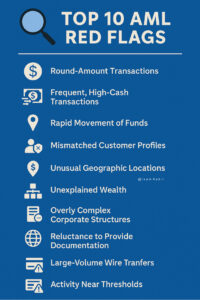Money laundering doesn’t scream from rooftops; it whispers through patterns. Only trained eyes can hear it. In today’s complex financial ecosystem, effective AML compliance strategies are more critical than ever. As regulators tighten controls and criminals refine their tactics, compliance professionals must remain alert, agile, and informed. The ability to detect early signs of illicit activity can make the difference between a compliant institution and one under investigation. This article identifies the top red flags that every AML officer should be aware of and provides practical steps for implementing effective AML compliance strategies within your organization.
Why You Need Effective AML Compliance Strategies in 2025
The global financial system processes trillions of transactions daily. Amid that flow, illicit funds often blend seamlessly with legitimate money. Effective AML compliance strategies are not just regulatory checklists; they are frontline defenses against terrorism financing, corruption, and organized crime.
According to the UNODC, between 2–5% of global GDP is laundered annually—over $2 trillion.
To address this, financial institutions must move beyond box-ticking exercises and adopt a proactive, risk-based AML framework.
Top 10 AML Red Flags to Watch For
Let’s explore some of the most common warning signs that indicate potential money laundering activity. These red flags should trigger further investigation and, when combined with contextual data, form the core of effective AML compliance strategies.
1. Round-Amount Transactions
Repeated transfers of large, even amounts (like $10,000 or $50,000) with no clear business rationale often suggest layering, a key stage of laundering.
2. Frequent, High-Cash Transactions
When customers regularly deposit or withdraw large amounts of cash, especially inconsistent with their profile, it’s a serious alert.
3. Rapid Movement of Funds
If money enters one account and quickly leaves to another, often across borders, it could signal an attempt to obscure its origin.
4. Mismatched Customer Profiles
When a customer claiming to be a teacher suddenly buys luxury real estate, or a student transfers millions, ask questions. This mismatch raises compliance concerns.
5. Unusual Geographic Activity
Transactions linked to high-risk jurisdictions, especially without a clear purpose, are strong indicators of illicit activity.
6. Unexplained Wealth
Sudden wealth accumulation without a verifiable source (e.g., multiple luxury purchases) is another classic laundering signal.
7. Overly Complex Corporate Structures
Shell companies, trusts, or offshore entities with hidden UBOs (Ultimate Beneficial Owners) are often used to obscure illicit funds.
8. Reluctance to Provide Documentation
A customer who avoids submitting KYC or Enhanced Due Diligence (EDD) documents may have something to hide.
9. Large-Volume Wire Transfers
Unjustified, high-frequency international wire transfers, especially without documentation, can indicate both layering and integration.
10. Transactions Just Below Reporting Thresholds
Also known as “structuring,” this tactic involves breaking large sums into smaller parts to avoid CTR (Currency Transaction Reports) filings.

Building Effective AML Compliance Strategies: Actionable Steps
Now that you know what to look for, let’s discuss how to build effective AML compliance strategies in your organization:
1. Train Your Team
Regular training helps staff identify suspicious patterns early. Use real-life examples and simulations to build muscle memory in your frontline teams.
2. Enhance Your KYC and EDD Processes
Go beyond form-filling. Use behavioral data, background checks, and independent verification to assess customer risk accurately.
3. Use Technology for Real-Time Monitoring
Deploy AI and machine learning tools to detect anomalies across accounts and flag unusual behaviors in real time.
4. Establish a Risk-Based Approach (RBA)
Not all customers pose the same risk. Tailor your controls based on geography, transaction type, customer profile, and industry.
5. Audit and Test Your Compliance Program
Conduct independent reviews of your AML systems to find blind spots. Regulatory expectations now include testing both your policies and your tech infrastructure.

Regulatory Landscape: Why Compliance Can’t Be Ignored
From the UAE Central Bank to FinCEN (USA), FATF, and EU AML Directives, regulators are sharpening their focus. Fines for non-compliance have skyrocketed. Institutions that fail to implement effective AML compliance strategies not only face penalties but also reputational damage.
In the UAE, regulators are increasingly scrutinizing DNFBPs (Designated Non-Financial Businesses and Professions) like law firms, real estate agencies, and auditors. The burden of compliance now stretches well beyond banks.
How to Measure the Effectiveness of Your AML Program
Implement KPIs like:
- Number of suspicious transaction reports (STRs) filed
- Average time to detect a red flag
- Percentage of staff trained annually
- False-positive rate from transaction monitoring systems
A high-performing AML program should balance automation with human expertise, reducing compliance fatigue while improving risk detection.
Final Thoughts: AML is a Continuous Journey, Not a One-Time Policy
Criminals evolve. So should your compliance efforts.
The most effective AML compliance strategies are living systems that constantly adapt, learn, and optimize. Red flags are just the beginning; true compliance lies in turning those signals into actionable intelligence.
“Over 80% of laundering cases show at least one of these red flags early on. Catching them isn’t just smart, it’s essential.”
By staying vigilant, training your team, and leveraging data-driven tools, you don’t just meet regulatory standards, you lead them.
Want to take your compliance systems to the next level?
Explore my in-depth blog on building visual dashboards tailored for regulators:
Data-Driven Compliance: Building Visual Dashboards for UAE Regulators — a must-read for every AML and risk professional aiming for clarity and control.
Stay Ahead, Stay Informed
Subscribe to isamkabir.com for regular updates, expert insights, and actionable strategies on compliance, governance, and financial crime prevention.


